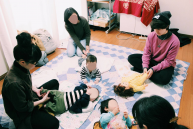For my CIP, I volunteered with Mitsuba Preschool twice a week as an English teacher and more general participant in daily activities. On Mondays, I joined the preschool for lunchtime, eating and playing outside, and on Thursdays I would come during after-hours, which was mainly indoor play.
Mitsuba is organized into three classes oldest to youngest: yurigumi (lily class, kindergarten-age), baragumi (rose class, pre-kindergarten), and momogumi (peach class, very pre-kindergarten). Although this was explained to me early on, it took a while to sink in. Similarly, there were other elements to the preschool, such as when and where we clean up, when it is appropriate to play, and how to dispose of a plastic bento box, that it felt like I struggled to learn. In general, I felt a lot of concern at first about fitting in and figuring out where I should be at any given time. However, the sensei’s and children were welcoming, it wasn’t long before I found myself more comfortable and invested, albeit not the most aware of every detail. Despite my lower level in the language, through smaller attempts at memorizing names or bringing proper supplies, I did my best to show the principal and teachers how much I wanted to be there, and they were hugely supportive. I also began to notice really interesting points about the preschool. For example, after playtime each day (which included activities like knitting, coloring, or construction using toys like Legos), the teachers would call up a few students to show the others what they had made. This was a fun way to see playtime being used for more specifically creative purposes, and I could tell the students loved the chance to see their effort validated. And the items that the students created truly were impressive: I watched a boy make a fully functioning (if not motorized) merry-go-round from a plastic construction-type playset.
Towards the beginning of the semester, I did activities like reading and singing in English, even singing “Let it Go” karaoke-style for all the kids during after-hours playtime. While that was a lot of fun and I hope the students enjoyed it, the most rewarding part of this semester was probably getting to know one particular student. During playtime, I noticed a student whose family more recently immigrated to Japan spent more time on the sidelines, so I approached him and we began to play together, most often communicating through gestures since neither of us could speak to each other in Japanese that well, let alone the other’s native language. Eventually he started to open up and seek me out, and I had the opportunity to see firsthand his work to adjust to the pace of the preschool. Just this week I spoke with another teacher about how much he has worked to learn Japanese: when I first arrived he was hardly speaking at all, but last week I watched him get through whole sentences. Being close enough to watch him improve alone made me feel the time I invested in the preschool was worthwhile.
Overall, I enjoyed the time I spent at Mitsuba and feel very grateful to have had the opportunity to get so uniquely involved in the community immediately surrounding Doshisha. If there is anything I have taken from the experience, it is gratefulness for the warm welcome of the teachers and students, and excitement for the future of the preschool, even if I cannot be there for it.

